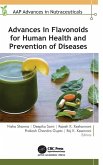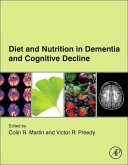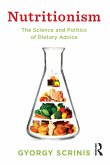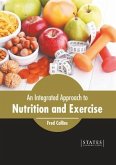- Gebundenes Buch
- Merkliste
- Auf die Merkliste
- Bewerten Bewerten
- Teilen
- Produkt teilen
- Produkterinnerung
- Produkterinnerung
This book gives registered dietitian nutritionists (RDNs) a heads up on what to listen for, with educational materials that address the everyday challenges many people, hence many RDNs, face.
Andere Kunden interessierten sich auch für
![Psoriasis and Psoriatic Arthritis Psoriasis and Psoriatic Arthritis]() Psoriasis and Psoriatic Arthritis237,99 €
Psoriasis and Psoriatic Arthritis237,99 €![Advances in Flavonoids for Human Health and Prevention of Diseases Advances in Flavonoids for Human Health and Prevention of Diseases]() Advances in Flavonoids for Human Health and Prevention of Diseases187,99 €
Advances in Flavonoids for Human Health and Prevention of Diseases187,99 €![Diet and Nutrition in Dementia and Cognitive Decline Diet and Nutrition in Dementia and Cognitive Decline]() Diet and Nutrition in Dementia and Cognitive Decline289,99 €
Diet and Nutrition in Dementia and Cognitive Decline289,99 €![Nutritionism Nutritionism]() Gyorgy ScrinisNutritionism64,99 €
Gyorgy ScrinisNutritionism64,99 €![An Integrated Approach to Nutrition and Exercise An Integrated Approach to Nutrition and Exercise]() An Integrated Approach to Nutrition and Exercise156,99 €
An Integrated Approach to Nutrition and Exercise156,99 €![Asian Crops and Human Dietetics Asian Crops and Human Dietetics]() Asian Crops and Human Dietetics165,99 €
Asian Crops and Human Dietetics165,99 €![Culinary Nutrition Culinary Nutrition]() Jacqueline B MarcusCulinary Nutrition103,99 €
Jacqueline B MarcusCulinary Nutrition103,99 €-
-
-
This book gives registered dietitian nutritionists (RDNs) a heads up on what to listen for, with educational materials that address the everyday challenges many people, hence many RDNs, face.
Hinweis: Dieser Artikel kann nur an eine deutsche Lieferadresse ausgeliefert werden.
Hinweis: Dieser Artikel kann nur an eine deutsche Lieferadresse ausgeliefert werden.
Produktdetails
- Produktdetails
- Verlag: CRC Press
- Seitenzahl: 216
- Erscheinungstermin: 28. März 2024
- Englisch
- Abmessung: 254mm x 178mm x 14mm
- Gewicht: 630g
- ISBN-13: 9781032352466
- ISBN-10: 1032352469
- Artikelnr.: 69483828
- Herstellerkennzeichnung
- Libri GmbH
- Europaallee 1
- 36244 Bad Hersfeld
- gpsr@libri.de
- Verlag: CRC Press
- Seitenzahl: 216
- Erscheinungstermin: 28. März 2024
- Englisch
- Abmessung: 254mm x 178mm x 14mm
- Gewicht: 630g
- ISBN-13: 9781032352466
- ISBN-10: 1032352469
- Artikelnr.: 69483828
- Herstellerkennzeichnung
- Libri GmbH
- Europaallee 1
- 36244 Bad Hersfeld
- gpsr@libri.de
Joyce Barretto Patterson, MPH, RDN, BC-ADM, CPT is a registered dietitian and a diabetes care and education specialist at Michigan Medicine in Ann Arbor. She also spent several years as a lifestyle coach for the Diabetes Prevention Program. She is a recurring speaker for the Association of Diabetes Care and Education Specialists, where she has presented on topics including behavior change, weight management, physical activity, and telehealth. She also serves as the preceptor for dietetic interns who rotate through her clinic. She is a recurring guest lecturer for the clinical nutrition class at the University of Michigan School of Public Health. She currently provides nutrition education and counseling for individuals with diabetes, obesity, hyperlipidemia, hypertension, and other nutrition-related conditions. She also provides group education to patients with diabetes and kidney disease. Prior to specializing in diabetes, she was a cardiovascular dietitian providing group education in cardiac rehab, as well as individual counseling for patients with lipid disorders, hypertension, and other risk factors for heart disease. Prior to becoming a registered dietitian, she spent several years working in marketing communications as an editor and graphic designer. Having earned both her Master of Public Health and Bachelor of Arts degrees at the University of Michigan, she bleeds Maize and Blue. Her undergraduate degree is in English Language and Literature. She continues to write, frequently contributing to various blogs and publications including the Food & Nutrition Magazine Stone Soup blog, the University of Michigan's health blog, the ADCES In Practice journal, and her personal blog thefeelingsnackyfix.com.
1. Introduction
a. What this book is
b. What this book is not
c. Why you need it
2. Part 1: SHARE
a. Chapter 1: SHARE - A Step-by-Step Approach to Nutrition Counseling
b. Chapter 2: Start with a Blank Sheet
i. Learning the Ropes
ii. Breaking The Ice
c. Chapter 3: Hear and Understand
i. The Patient-Dietitian Relationship
ii. Cultivating Empathy
iii. Communicating Compassion
iv. Compassion Starts from Within
v. Beneath the Surface
vi. Implicit Bias
vii. Limits and Boundaries
d. Chapter 4: Assess and Review
i. Understand the science.
ii. Think like a dietitian.
iii. Speak like a person.
e. Chapter 5: Empower the Patient
i. Goal Setting, Problem Solving, and Action Planning
3. Part 2: Everyday Eating Routines: A Different EER
a. Chapter 6: Motivations and Barriers
b. Chapter 7: A Different EER
i. Everybody Eats
ii. Everyday Eating Routines: A Different EER
c. Chapter 8: Commonly Reported Eating Patterns
i. Night Snacking
ii. Skipping Meals
iii. Squeezing Calories and Chasing Hunger
iv. Emotional Eating
v. All or Nothing
vi. Grazing
vii. Frequent Dining Out
viii. Habit Cycling
ix. A Multifactorial Pattern
4. Part 3: Common Referrals and FAQs
a. Chapter 9: Common Referrals
b. Chapter 10: Type 2 Diabetes and Prediabetes
i. What You Need to Know
ii. What Patients Want to Know
iii. What Patients Need to Know
c. Chapter 11: Heart Disease Prevention and Management
i. Dyslipidemia
1. What You Need to Know
2. What Patients Want to Know
3. What Patients Need to Know
ii. Hypertension
1. What You Need to Know
2. What Patients Want to Know
3. What Patients Need to Know
d. Chapter 12: Chronic Kidney Disease
1. What You Need to Know
2. What Patients Want to Know
3. What Patients Need to Know
e. Chapter 13: IBS and the Low FODMAP Diet
1. What You Need to Know
2. What Patients Want to Know
3. What Patients Need to Know
f. Chapter 14: Weight Counseling
1. What You Need to Know
2. What Patients Want to Know
3. What Patients Need to Know
5. Part 4: Putting It All Together
a. Chapter 15: Health Literacy
i. What is health literacy?
ii. Know Your Audience
iii. Tailor the Education
iv. Consider Learning and Teaching Styles
v. Use Various Teaching Modalities
b. Chapter 16: Cultural Competence
i. What is cultural competence?
c. Chapter 17: SHARE Your Screen - and Other Virtual Care Tips
i. Lessons Learned
ii. Best Practices, Challenges, and Opportunities
d. Chapter 18: Making PLANS and Taking Action
i. Making PLANS
ii. Turning PLANS Into Action
Supplements available online
Handouts for FAQs
1. What can I have for breakfast?
2. What can I have for snacks?
3. How much protein do I need?
4. How can I find time to cook?
5. How can I eat healthy on a budget?
Educational slides
1. Prediabetes and Type 2 Diabetes
2. Nutrition and Heart Health
3. Protecting Your Kidneys
4. IBS and the Low FODMAP diet
5. Nutrition and Weight Management
Counseling handouts
1. Goal setting and action planning worksheet
2. Tips for successful food and physical activity tracking
a. What this book is
b. What this book is not
c. Why you need it
2. Part 1: SHARE
a. Chapter 1: SHARE - A Step-by-Step Approach to Nutrition Counseling
b. Chapter 2: Start with a Blank Sheet
i. Learning the Ropes
ii. Breaking The Ice
c. Chapter 3: Hear and Understand
i. The Patient-Dietitian Relationship
ii. Cultivating Empathy
iii. Communicating Compassion
iv. Compassion Starts from Within
v. Beneath the Surface
vi. Implicit Bias
vii. Limits and Boundaries
d. Chapter 4: Assess and Review
i. Understand the science.
ii. Think like a dietitian.
iii. Speak like a person.
e. Chapter 5: Empower the Patient
i. Goal Setting, Problem Solving, and Action Planning
3. Part 2: Everyday Eating Routines: A Different EER
a. Chapter 6: Motivations and Barriers
b. Chapter 7: A Different EER
i. Everybody Eats
ii. Everyday Eating Routines: A Different EER
c. Chapter 8: Commonly Reported Eating Patterns
i. Night Snacking
ii. Skipping Meals
iii. Squeezing Calories and Chasing Hunger
iv. Emotional Eating
v. All or Nothing
vi. Grazing
vii. Frequent Dining Out
viii. Habit Cycling
ix. A Multifactorial Pattern
4. Part 3: Common Referrals and FAQs
a. Chapter 9: Common Referrals
b. Chapter 10: Type 2 Diabetes and Prediabetes
i. What You Need to Know
ii. What Patients Want to Know
iii. What Patients Need to Know
c. Chapter 11: Heart Disease Prevention and Management
i. Dyslipidemia
1. What You Need to Know
2. What Patients Want to Know
3. What Patients Need to Know
ii. Hypertension
1. What You Need to Know
2. What Patients Want to Know
3. What Patients Need to Know
d. Chapter 12: Chronic Kidney Disease
1. What You Need to Know
2. What Patients Want to Know
3. What Patients Need to Know
e. Chapter 13: IBS and the Low FODMAP Diet
1. What You Need to Know
2. What Patients Want to Know
3. What Patients Need to Know
f. Chapter 14: Weight Counseling
1. What You Need to Know
2. What Patients Want to Know
3. What Patients Need to Know
5. Part 4: Putting It All Together
a. Chapter 15: Health Literacy
i. What is health literacy?
ii. Know Your Audience
iii. Tailor the Education
iv. Consider Learning and Teaching Styles
v. Use Various Teaching Modalities
b. Chapter 16: Cultural Competence
i. What is cultural competence?
c. Chapter 17: SHARE Your Screen - and Other Virtual Care Tips
i. Lessons Learned
ii. Best Practices, Challenges, and Opportunities
d. Chapter 18: Making PLANS and Taking Action
i. Making PLANS
ii. Turning PLANS Into Action
Supplements available online
Handouts for FAQs
1. What can I have for breakfast?
2. What can I have for snacks?
3. How much protein do I need?
4. How can I find time to cook?
5. How can I eat healthy on a budget?
Educational slides
1. Prediabetes and Type 2 Diabetes
2. Nutrition and Heart Health
3. Protecting Your Kidneys
4. IBS and the Low FODMAP diet
5. Nutrition and Weight Management
Counseling handouts
1. Goal setting and action planning worksheet
2. Tips for successful food and physical activity tracking
1. Introduction
a. What this book is
b. What this book is not
c. Why you need it
2. Part 1: SHARE
a. Chapter 1: SHARE - A Step-by-Step Approach to Nutrition Counseling
b. Chapter 2: Start with a Blank Sheet
i. Learning the Ropes
ii. Breaking The Ice
c. Chapter 3: Hear and Understand
i. The Patient-Dietitian Relationship
ii. Cultivating Empathy
iii. Communicating Compassion
iv. Compassion Starts from Within
v. Beneath the Surface
vi. Implicit Bias
vii. Limits and Boundaries
d. Chapter 4: Assess and Review
i. Understand the science.
ii. Think like a dietitian.
iii. Speak like a person.
e. Chapter 5: Empower the Patient
i. Goal Setting, Problem Solving, and Action Planning
3. Part 2: Everyday Eating Routines: A Different EER
a. Chapter 6: Motivations and Barriers
b. Chapter 7: A Different EER
i. Everybody Eats
ii. Everyday Eating Routines: A Different EER
c. Chapter 8: Commonly Reported Eating Patterns
i. Night Snacking
ii. Skipping Meals
iii. Squeezing Calories and Chasing Hunger
iv. Emotional Eating
v. All or Nothing
vi. Grazing
vii. Frequent Dining Out
viii. Habit Cycling
ix. A Multifactorial Pattern
4. Part 3: Common Referrals and FAQs
a. Chapter 9: Common Referrals
b. Chapter 10: Type 2 Diabetes and Prediabetes
i. What You Need to Know
ii. What Patients Want to Know
iii. What Patients Need to Know
c. Chapter 11: Heart Disease Prevention and Management
i. Dyslipidemia
1. What You Need to Know
2. What Patients Want to Know
3. What Patients Need to Know
ii. Hypertension
1. What You Need to Know
2. What Patients Want to Know
3. What Patients Need to Know
d. Chapter 12: Chronic Kidney Disease
1. What You Need to Know
2. What Patients Want to Know
3. What Patients Need to Know
e. Chapter 13: IBS and the Low FODMAP Diet
1. What You Need to Know
2. What Patients Want to Know
3. What Patients Need to Know
f. Chapter 14: Weight Counseling
1. What You Need to Know
2. What Patients Want to Know
3. What Patients Need to Know
5. Part 4: Putting It All Together
a. Chapter 15: Health Literacy
i. What is health literacy?
ii. Know Your Audience
iii. Tailor the Education
iv. Consider Learning and Teaching Styles
v. Use Various Teaching Modalities
b. Chapter 16: Cultural Competence
i. What is cultural competence?
c. Chapter 17: SHARE Your Screen - and Other Virtual Care Tips
i. Lessons Learned
ii. Best Practices, Challenges, and Opportunities
d. Chapter 18: Making PLANS and Taking Action
i. Making PLANS
ii. Turning PLANS Into Action
Supplements available online
Handouts for FAQs
1. What can I have for breakfast?
2. What can I have for snacks?
3. How much protein do I need?
4. How can I find time to cook?
5. How can I eat healthy on a budget?
Educational slides
1. Prediabetes and Type 2 Diabetes
2. Nutrition and Heart Health
3. Protecting Your Kidneys
4. IBS and the Low FODMAP diet
5. Nutrition and Weight Management
Counseling handouts
1. Goal setting and action planning worksheet
2. Tips for successful food and physical activity tracking
a. What this book is
b. What this book is not
c. Why you need it
2. Part 1: SHARE
a. Chapter 1: SHARE - A Step-by-Step Approach to Nutrition Counseling
b. Chapter 2: Start with a Blank Sheet
i. Learning the Ropes
ii. Breaking The Ice
c. Chapter 3: Hear and Understand
i. The Patient-Dietitian Relationship
ii. Cultivating Empathy
iii. Communicating Compassion
iv. Compassion Starts from Within
v. Beneath the Surface
vi. Implicit Bias
vii. Limits and Boundaries
d. Chapter 4: Assess and Review
i. Understand the science.
ii. Think like a dietitian.
iii. Speak like a person.
e. Chapter 5: Empower the Patient
i. Goal Setting, Problem Solving, and Action Planning
3. Part 2: Everyday Eating Routines: A Different EER
a. Chapter 6: Motivations and Barriers
b. Chapter 7: A Different EER
i. Everybody Eats
ii. Everyday Eating Routines: A Different EER
c. Chapter 8: Commonly Reported Eating Patterns
i. Night Snacking
ii. Skipping Meals
iii. Squeezing Calories and Chasing Hunger
iv. Emotional Eating
v. All or Nothing
vi. Grazing
vii. Frequent Dining Out
viii. Habit Cycling
ix. A Multifactorial Pattern
4. Part 3: Common Referrals and FAQs
a. Chapter 9: Common Referrals
b. Chapter 10: Type 2 Diabetes and Prediabetes
i. What You Need to Know
ii. What Patients Want to Know
iii. What Patients Need to Know
c. Chapter 11: Heart Disease Prevention and Management
i. Dyslipidemia
1. What You Need to Know
2. What Patients Want to Know
3. What Patients Need to Know
ii. Hypertension
1. What You Need to Know
2. What Patients Want to Know
3. What Patients Need to Know
d. Chapter 12: Chronic Kidney Disease
1. What You Need to Know
2. What Patients Want to Know
3. What Patients Need to Know
e. Chapter 13: IBS and the Low FODMAP Diet
1. What You Need to Know
2. What Patients Want to Know
3. What Patients Need to Know
f. Chapter 14: Weight Counseling
1. What You Need to Know
2. What Patients Want to Know
3. What Patients Need to Know
5. Part 4: Putting It All Together
a. Chapter 15: Health Literacy
i. What is health literacy?
ii. Know Your Audience
iii. Tailor the Education
iv. Consider Learning and Teaching Styles
v. Use Various Teaching Modalities
b. Chapter 16: Cultural Competence
i. What is cultural competence?
c. Chapter 17: SHARE Your Screen - and Other Virtual Care Tips
i. Lessons Learned
ii. Best Practices, Challenges, and Opportunities
d. Chapter 18: Making PLANS and Taking Action
i. Making PLANS
ii. Turning PLANS Into Action
Supplements available online
Handouts for FAQs
1. What can I have for breakfast?
2. What can I have for snacks?
3. How much protein do I need?
4. How can I find time to cook?
5. How can I eat healthy on a budget?
Educational slides
1. Prediabetes and Type 2 Diabetes
2. Nutrition and Heart Health
3. Protecting Your Kidneys
4. IBS and the Low FODMAP diet
5. Nutrition and Weight Management
Counseling handouts
1. Goal setting and action planning worksheet
2. Tips for successful food and physical activity tracking








